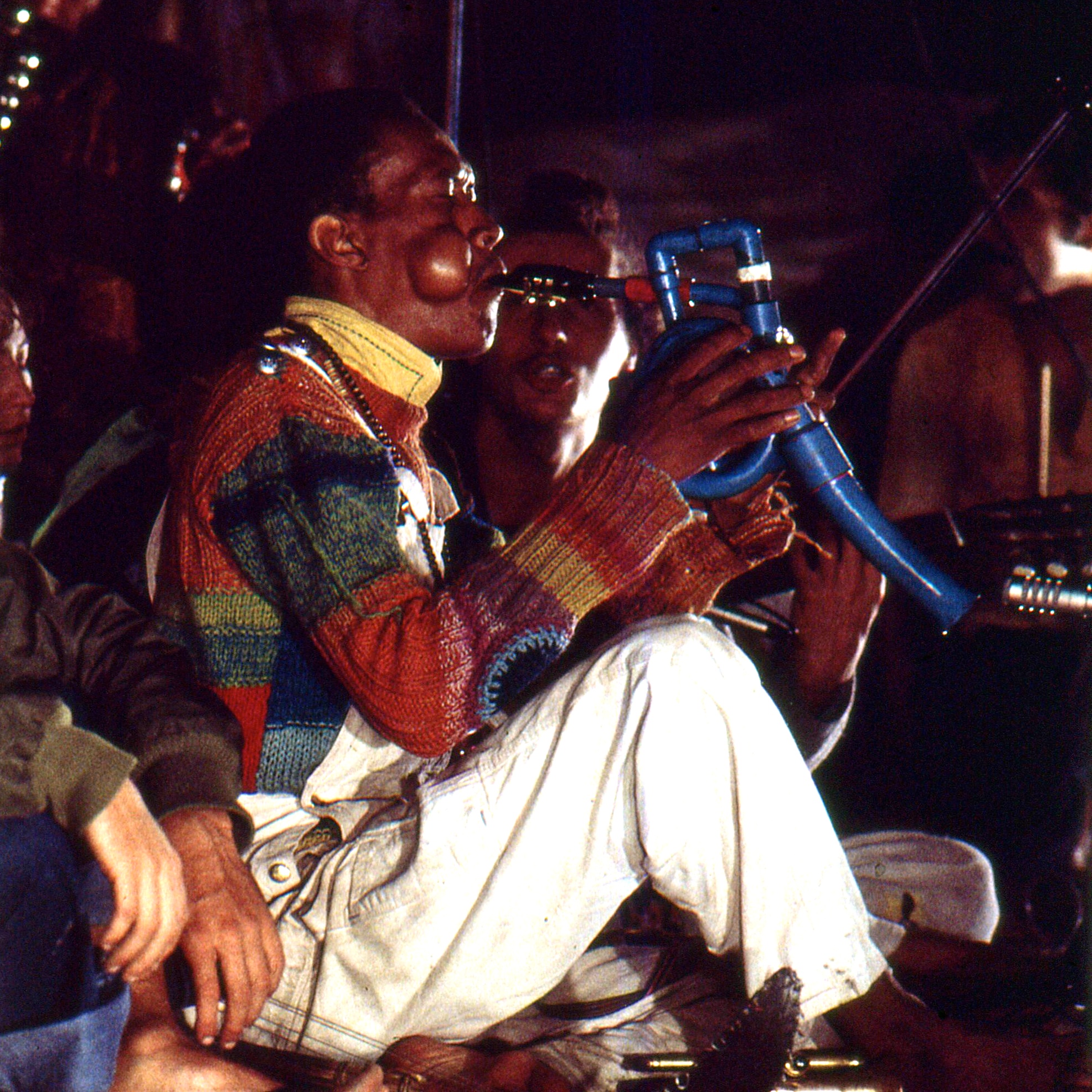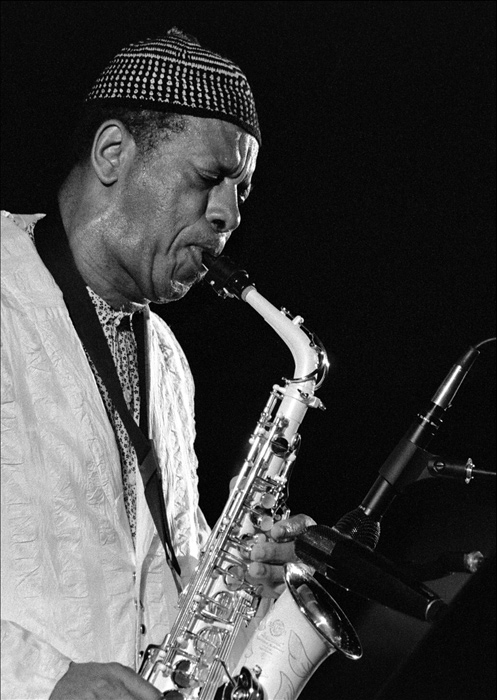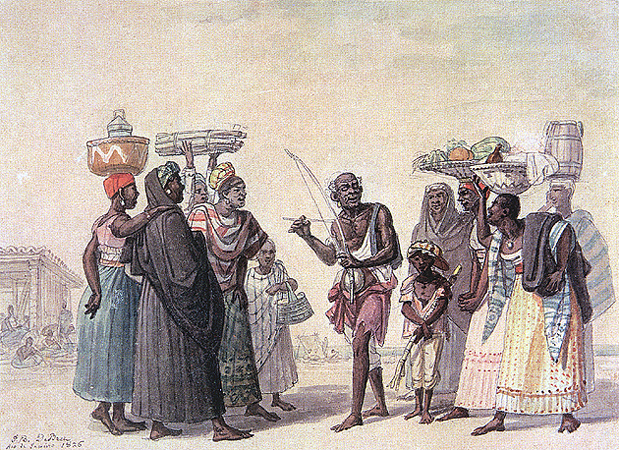|
Om Shanti Om (album)
''Om Shanti Om'' is a live album by multi-instrumentalist Don Cherry. It was recorded in 1976 at RAI Studios in Rome, Italy, for television broadcast, and was released in 2020 by Black Sweat Records. On the album, Cherry is heard on pocket trumpet, ngoni, kora, and flute, and is joined by Naná Vasconcelos on berimbau, Gian Piero Pramaggiore on guitar, and his wife Moki Cherry on tambura. Reception In a review for '' Jazzwise'', Edwin Pouncey wrote that, on the album, "the hard-edged urban blast of 1960s modern jazz is replaced with a more meditational organic music groove where the assembled players become sonically entwined. Here vocal chant and percussion are utilised to form densely patterned layers of undulating rhythm." Stef Gijssels of ''The Free Jazz Collective'' stated: "It is all very friendly and sweet, with no real moments of surprise and no sense of artistic commitment, and as such it's more like listening to a group of friends having fun." A writer for ''Koma ... [...More Info...] [...Related Items...] OR: [Wikipedia] [Google] [Baidu] |
Don Cherry (trumpeter)
Donald Eugene Cherry (November 18, 1936 – October 19, 1995) was an American jazz trumpeter. Cherry had a long association with free jazz saxophonist Ornette Coleman, which began in the late 1950s. He also performed alongside musicians such as John Coltrane, Charlie Haden, Sun Ra, Ed Blackwell, the New York Contemporary Five, and Albert Ayler. In the 1970s, Cherry became a pioneer in world fusion music, drawing on traditional African, Middle Eastern, and Hindustani music. He was a member of the ECM group Codona, along with percussionist Naná Vasconcelos and sitar and tabla player Collin Walcott. AllMusic called him "one of the most influential jazz musicians of the late 20th century." Early life Cherry was born in Oklahoma City, Oklahoma, to a mother of Choctaw descent and an African-American father. His mother and grandmother played piano and his father played trumpet. His father owned Oklahoma City's Cherry Blossom Club, which hosted performances by Charlie Christian an ... [...More Info...] [...Related Items...] OR: [Wikipedia] [Google] [Baidu] |
Free Jazz
Free jazz is an experimental approach to jazz improvisation that developed in the late 1950s and early 1960s when musicians attempted to change or break down jazz conventions, such as regular tempos, tones, and chord changes. Musicians during this period believed that the bebop, hard bop, and modal jazz that had been played before them was too limiting. They became preoccupied with creating something new and exploring new directions. The term "free jazz" has often been combined with or substituted for the term "avant-garde jazz". Europeans tend to favor the term "free improvisation". Others have used "modern jazz", "creative music", and "art music". The ambiguity of free jazz presents problems of definition. Although it is usually played by small groups or individuals, free jazz big bands have existed. Although musicians and critics claim it is innovative and forward-looking, it draws on early styles of jazz and has been described as an attempt to return to primitive, often re ... [...More Info...] [...Related Items...] OR: [Wikipedia] [Google] [Baidu] |
Ngoni (instrument)
The ngoni (also written ''ngɔni'', ''n'goni'', or ''nkoni'') is a string instrument and a traditional West African guitar. Its body is made of wood or calabash with dried animal (often goat) skin head stretched over it. The ngoni, which can produce fast melodies, appears to be closely related to the ''akonting'' and the ''xalam''. This is called a ''jeli ngoni'' as it is played by griots at celebrations and special occasions in traditional songs called ''fasa''s in Mandingo. Another larger type, believed to have originated among the donso (a hunter and storyteller caste of the Wassoulou cultural region) is called the ''donso ngoni''. This is still largely reserved for ceremonial purposes. The donso ngoni, or "hunter's harp," has six strings. It is often accompanies singing along with the '' karagnan'', a serrated metal tube scraped with a metal stick. The donso ngoni was mentioned by Richard Jobson in the 1620s, describing it as the most commonly used instrument in the Gambia. H ... [...More Info...] [...Related Items...] OR: [Wikipedia] [Google] [Baidu] |
Kora (instrument)
The kora (Manding languages: ''köra'') is a stringed instrument used extensively in West Africa. A kora typically has 21 strings, which are played by plucking with the fingers. It combines features of the lute and harp. Description The kora is built from gourd, cut in half and covered with cow skin to make a resonator with a long hardwood neck. The skin is supported by two handles that run underneath it. It has 21 strings, each of which plays a different note. These strings are supported by a notched, double free-standing bridge. The kora doesn't fit into any one category of musical instrument, but rather several, and must be classified as a "double-bridge-harp-lute." The strings run in two divided ranks, characteristic of a double harp. They do not end in a soundboard but are instead held in notches on a bridge, classifying it as a bridge harp. The strings originate from a string arm or neck and cross a bridge directly supported by a resonating chamber, also making it a lute ... [...More Info...] [...Related Items...] OR: [Wikipedia] [Google] [Baidu] |
Naná Vasconcelos
Juvenal de Holanda Vasconcelos, known as Naná Vasconcelos (2 August 1944 – 9 March 2016), was a Brazilian percussionist, vocalist and berimbau player, notable for his work as a solo artist on over two dozen albums, and as a backing musician with Pat Metheny, Don Cherry, Björk, Jan Garbarek, Egberto Gismonti, Gato Barbieri, and Milton Nascimento. Biography Vasconcelos was born in Recife, Brazil. Beginning from 1967 he joined many artists' works as a percussionist. Among his many collaborations, he contributed to four Jon Hassell albums from 1976 to 1980 (including '' Possible Musics'' by Brian Eno and Hassell), and later to several Pat Metheny Group works and Jan Garbarek concerts from early 1980s to early 1990s. In 1984 he appeared on the Pierre Favre album ''Singing Drums'' along with Paul Motian. He also appears on Arild Andersen's album ''If You Look Far Enough'' with Ralph Towner. He formed a group named Codona with Don Cherry and Collin Walcott, which released three albu ... [...More Info...] [...Related Items...] OR: [Wikipedia] [Google] [Baidu] |
Berimbau
The berimbau () is a single-string percussion instrument, a musical bow, originally from Africa, that is now commonly used in Brazil. The berimbau would eventually be incorporated into the practice of the Afro-Brazilian martial art ''capoeira'', the berimbau leads the capoeiristas movement in the ''roda''—the faster the berimbau is playing the faster the capoeirista moves in the game. The instrument is known for being the subject matter of a popular song by Brazilian guitarist Baden Powell, with lyrics by Vinicius de Moraes. The instrument is also a part of Candomblé-de-caboclo tradition. History The berimbau's origins have not been fully researched, though it is most likely an adaptation of African gourde musical bows, as no Indigenous Brazilian or European people use musical bows. The way the ''berimbau'' and the ''m'bulumbumba'' of southwest Angola are made and played are very similar, as well as the tuning and basic patterns performed on these instruments. The ass ... [...More Info...] [...Related Items...] OR: [Wikipedia] [Google] [Baidu] |
Moki Cherry
Moki Cherry (born Monika Marianne Karlsson; 8 February 1943 – 29 August 2009) was a Swedish interdisciplinary artist and designer who worked in textiles, fashion design, woodworks, painting, collage, ceramics and set design. Her practice traversed the worlds of art, music and theater with diverse influences such as Indian art and music, Tibetan Buddhism, fashion, traditional folk arts and dress, abstraction, cartoons and Pop art. From 1977 she split her time living between Tågarp, Sweden and Long Island City in New York, USA. Moki collaborated with her husband, the American jazz trumpeter, Don Cherry, throughout her lifetime – they performed in concerts as Organic Music, where her artworks were also displayed, and ran workshops for children. Her designs also appeared on Don's album covers and as costumes worn by him in concert. Early life Moki Cherry was born Monika Marianne Karlsson on 8 February 1943 in Koler in Norrbotten, Sweden. Her father, Verner Karlsson, ran the sta ... [...More Info...] [...Related Items...] OR: [Wikipedia] [Google] [Baidu] |
Tanpura
The tanpura (), also referred to as tambura and tanpuri, is a long-necked plucked string instrument, originating in India, found in various forms in Indian music. It does not play melody, but rather supports and sustains the melody of another instrument or singer by providing a continuous harmonic bourdon or drone. A tanpura is not played in rhythm with the soloist or percussionist: as the precise timing of plucking a cycle of four strings in a continuous loop is a determinant factor in the resultant sound, it is played unchangingly during the complete performance. The repeated cycle of plucking all strings creates the sonic canvas on which the melody of the raga is drawn. The combined sound of all strings–each string a fundamental tone with its own spectrum of overtones–supports and blends with the external tones sung or played by the soloist. Hindustani musicians favour the term ''tanpura'' whereas Carnatic musicians say ''tambura''; ''tanpuri'' is a smaller varian ... [...More Info...] [...Related Items...] OR: [Wikipedia] [Google] [Baidu] |
Jazzwise
''Jazzwise'', launched in 1997, is the UK jazz monthly magazine. ''Jazzwise'' has a broad sub-genre coverage, from jazz, improv, hard bop, and jazz-rock to bebop and classic jazz, and also covers jazz crossover, including jazz-funk, jazz hip-hop and jazz-electronica. It features news coverage, a national gig guide, gossip column, a jazz-on-film page, opinion column, in-depth features and a review section covering new CD releases, reissues, vinyl, DVDs, books and live reviews. Breaking news stories also feature on the ''Jazzwise'' magazine website. ''Jazzwise'' also mentors new jazz writers through its ongoing intern scheme and the Write Stuff workshops held each November during the London Jazz Festival. The ''Jazzwise'' app features the full edition of the magazine and was the first jazz magazine app in the iTunes Newsstand. 100 Best Jazz Albums of All Time The September 2009 issue of ''Jazzwise'' was titled "The 100 Jazz Albums That Shook the World", conceived by Jon Newey ... [...More Info...] [...Related Items...] OR: [Wikipedia] [Google] [Baidu] |
Tom Hull – On The Web
Tom Hull is an American music critic, web designer, and former software developer. Hull began writing criticism for ''The Village Voice'' in the mid 1970s under the mentorship of its music editor Robert Christgau, but left the field to pursue a career in software design and engineering during the 1980s and 1990s, which earned him the majority of his life's income. In the 2000s, he returned to music reviewing and wrote a jazz column for ''The Village Voice'' in the manner of Christgau's "Consumer Guide", alongside contributions to ''Seattle Weekly'', ''The New Rolling Stone Album Guide'', NPR Music, and the webzine ''Static Multimedia''. Hull's jazz-focused database and blog ''Tom Hull – on the Web'' hosts his reviews and information on albums he has surveyed, as well as writings on books, politics, and movies. It shares a functional, low-graphic design with Christgau's website, which Hull also created and maintains as its webmaster. Career In the mid 1970s, Hull accepted a job ... [...More Info...] [...Related Items...] OR: [Wikipedia] [Google] [Baidu] |



